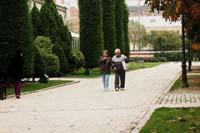Why suffer chronic pain?

Pain causes great restlessness and, along with aggressive pain, we often wonder the sense of suffering so much. But, although understanding can also be difficult, pain has its raison d'être, like most physiological reactions: pain is an ideal alarm system.
Pain warns us that something in our body does not work properly. Therefore, pain is a sign of injury or illness and good health control requires an alarm system. However, when the intensity of pain is unbearable or lasts longer than enough, it loses its original function and becomes a problem.
It is understood by chronic pain that lasts more than 6 months and cannot be easily discarded with conventional treatments. It may be due to a chronic illness or even an injury that we have not managed to cure completely. And sometimes chronic pain from nerve injury can appear.
If the pain lasts more than four weeks, you should see a pain treatment specialist or pain units in almost all hospitals. These units treat pain from different disciplines (neurology, psychology, physiotherapy, etc. ). In severe cases, combining several types of treatment is proven to be the best way to fight pain.
How to relieve pain?
Pain treatments usually work well, but it should be noted that pain is a very subjective experience, so it can be difficult to measure and calibrate the results. The same treatment may work differently with one person or another. For this reason, and especially in difficult cases, personalized treatment and monitoring of the evolution of treatment is recommended.
These treatments are usually long and relatively complex. Immediate results should not be expected or pain relieved and gone. In many cases, it will also be necessary to change the strategy several times to find the most effective treatment.

In general treatment, several ways may be used:
Medicines
The administration of medicines is carried out following guidelines established by the World Health Organization (WHO), always starting with the lowest dose.
When the pain is not yet very severe, you have to start with anti-inflammatory drugs (acetaminophen, aspirin, etc. ). ). To increase the effectiveness of these medicines can be combined with antidepressant drugs. Next mild opioid steps (e.g. code). When the pain is severe and the front steps have not worked, strong opioids (morphine) will be used.
Infiltrations
They are injected into the area of direct pain or into the nerves that cause pain. If the treatment should be long, a small device can be placed under the surface to release the medication constantly and steadily.
Electrical stimulation
In the skin, or under the skin surgically, a stimulating device is applied, usually close to the nervous system (spinal cord, nerves, etc. ). Its function is to reduce the feeling of pain through small electric discharges.
Rehabilitation
The aim of this method is to perform controlled movements that strengthen the affected area and relieve pain.
Nerve block
This technique locates the nerve that produces pain and breaks the nerve impulse with chemicals, heat or cold.





